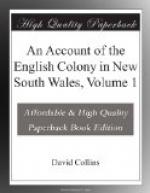[* Mr. Duncan McEver. He belonged to the Atlantic, which ship he quitted at Bengal.]
As intentions of this kind had been talked of in several ships, the military guard should never have been less than an officer’s command, and that guard (especially when embarked for the security of a ship full of wild lawless Irish) ought never to have been composed either of young soldiers, or of deserters from other corps.
This ship had a quick passage from Rio de Janeiro, arriving here in sixty-five days from that port. She brought the following quantity of provisions and stores for the colony:
Beef 46 tierces 15,496 ) 31,496
pounds;
Shipped at Cork 80 barrels
16,000 )
Pork 92 tierces 29,440 ] 45,440
pounds;
Shipped at Cork 80 barrels
16,000 ]
Flour 192 barrels, 64,512
pounds;
Lime-stone, shipped at Cork 44
tons;
Clothing and necessaries 17
bales and 5 cases
The convicts arrived in a very healthy state, nor was any one lost by sickness during the voyage.
Captain Paterson, of the New South Wales corps, an account of whose journeys in Africa appeared in print some years ago, conceiving that he might be able to penetrate as far as, or even beyond, the western mountains (commonly known in the colony by the name of the Blue Mountains, from the appearance which land so high and distant generally wears), set off from the settlement with a small party of gentlemen (Captain Johnston, Mr. Palmer, and Mr. Laing the assistant-surgeon) well provided with arms, and having provisions and necessaries sufficient for a journey of six weeks, to make the attempt. Boats were sent round to Broken Bay, whence they got into the Hawkesbury, and the fourth day reached as far as Richmond Hill. At this place, in the year 1789, the governor’s progress up the river was obstructed by a fall of water, which his boats were too heavy to drag over. This difficulty Captain Paterson overcame by quitting his large boats, and proceeding from Richmond Hill with two that were smaller and lighter. He found that this part of the river carried him to the westward, and into the chasm that divided the high land seen from Richmond Hill. Hither, however, he got with great difficulty and some danger, meeting in the space of about ten miles with not less than five waterfalls, one of which was rather steep, and was running at the rate of ten or twelve miles an hour. Above this part the water was about fifteen yards from side to side, and came down with some rapidity, a fall of rain having swollen the stream. Their navigation was here so intricate, lying between large pieces of rock that had been borne down by torrents, and some stumps of trees which they could not always see, that (after having loosened a plank in one boat, and driven the other upon a stump which forced its way through her bottom) they gave up any further progress, leaving the western mountains to be the object of discovery at some future day. It was supposed that they had proceeded ten miles farther up the river than had ever before been done, and named that part of it which until then had been unseen, ‘the Grose;’ and a high peak of land, which they had in view in the chasm, they called ’Harrington Peak.’




